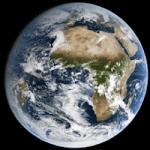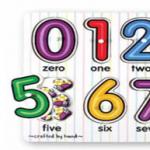Solar eclipse- an astronomical phenomenon that consists in the fact that Moon covers (eclipses) completely or partially Sun from the observer. A solar eclipse is only possible in new moon , when the side of the Moon facing the Earth is not illuminated and the Moon itself is not visible.
Eclipses are only possible if the new moon occurs near one of two lunar nodes (the point of intersection of the apparent orbits of the Moon and the Sun), no more than about 12 degrees from one of them.The Moon's shadow on the earth's surface does not exceed 270 km in diameter, so a solar eclipse is observed only in a narrow strip along the path of the shadow.
READ ALSO:
 Since the Moon revolves in an elliptical orbit, the distance between the Earth and the Moon at the time of an eclipse can be different; accordingly, the diameter of the lunar shadow spot on the Earth’s surface can vary widely from maximum to zero (when the top of the lunar shadow cone does not reach the Earth’s surface). If the observer is in the shadow band, he seestotal solar eclipse,
in which the Moon completely hidesSun , the sky darkens, and planets and bright stars may appear on it. Around the solar disk hidden by the Moon you can observe , which is not visible in the normal bright light of the Sun. When an eclipse is observed by a stationary ground-based observer, the total phase lasts no more than a few minutes. The minimum speed of movement of the lunar shadow on the earth's surface is just over 1 km/s. During a total solar eclipse astronauts in orbit , can observe the running shadow of the Moon on the surface of the Earth.Observers close to the total eclipse can see it aspartial solar eclipse.
During a partial eclipse, the Moon passes throughdisk of the Sun not exactly in the center, hiding only part of it. At the same time, the sky darkens much less than during a total eclipse, and the stars do not appear. A partial eclipse can be observed at a distance of about two thousand kilometers from the total eclipse zone.The totality of a solar eclipse is also expressed by the phaseΦ
. The maximum phase of a partial eclipse is usually expressed in hundredths of unity, where 1 is the total phase of the eclipse. The total phase can be greater than unity, for example 1.01, if the diameter of the visible lunar disk is greater than the diameter of the visible solar disk. Partial phases have a value less than 1. At the edge of the lunar penumbra, the phase is 0.The moment when the leading/rear edge of the Moon's disk touches the edge The sun is calledtouch. The first touch is the moment when the Moon enterssolar disk (the beginning of the eclipse, its partial phase). The last touch (the fourth in the case of a total eclipse) is the last moment of the eclipse, when the Moon leaves solar disk . In the case of a total eclipse, the second touch is the moment when the front of the Moon, having passed over the entire to the sun , begins to exit the disk. A total solar eclipse occurs between the second and third touches. In 600 million yearstidal acceleration will move the moon awayso far from the Earth that a total solar eclipse will become impossible.
Since the Moon revolves in an elliptical orbit, the distance between the Earth and the Moon at the time of an eclipse can be different; accordingly, the diameter of the lunar shadow spot on the Earth’s surface can vary widely from maximum to zero (when the top of the lunar shadow cone does not reach the Earth’s surface). If the observer is in the shadow band, he seestotal solar eclipse,
in which the Moon completely hidesSun , the sky darkens, and planets and bright stars may appear on it. Around the solar disk hidden by the Moon you can observe , which is not visible in the normal bright light of the Sun. When an eclipse is observed by a stationary ground-based observer, the total phase lasts no more than a few minutes. The minimum speed of movement of the lunar shadow on the earth's surface is just over 1 km/s. During a total solar eclipse astronauts in orbit , can observe the running shadow of the Moon on the surface of the Earth.Observers close to the total eclipse can see it aspartial solar eclipse.
During a partial eclipse, the Moon passes throughdisk of the Sun not exactly in the center, hiding only part of it. At the same time, the sky darkens much less than during a total eclipse, and the stars do not appear. A partial eclipse can be observed at a distance of about two thousand kilometers from the total eclipse zone.The totality of a solar eclipse is also expressed by the phaseΦ
. The maximum phase of a partial eclipse is usually expressed in hundredths of unity, where 1 is the total phase of the eclipse. The total phase can be greater than unity, for example 1.01, if the diameter of the visible lunar disk is greater than the diameter of the visible solar disk. Partial phases have a value less than 1. At the edge of the lunar penumbra, the phase is 0.The moment when the leading/rear edge of the Moon's disk touches the edge The sun is calledtouch. The first touch is the moment when the Moon enterssolar disk (the beginning of the eclipse, its partial phase). The last touch (the fourth in the case of a total eclipse) is the last moment of the eclipse, when the Moon leaves solar disk . In the case of a total eclipse, the second touch is the moment when the front of the Moon, having passed over the entire to the sun , begins to exit the disk. A total solar eclipse occurs between the second and third touches. In 600 million yearstidal acceleration will move the moon awayso far from the Earth that a total solar eclipse will become impossible.
Astronomical classification of solar eclipses. -According to astronomical classification, if an eclipse at least somewhere on the Earth's surface can be observed as total, it is called full. If an eclipse can only be observed as a partial eclipse (this happens when the cone of the Moon's shadow passes close to the earth's surface, but does not touch it), the eclipse is classified as private. When an observer is in the shadow of the Moon, he is observing a total solar eclipse. When he is in the area penumbra , he can observe a partial solar eclipse. In addition to total and partial solar eclipses, there areannular eclipses. An annular eclipse occurs when the Moon is further away from the Earth at the time of the eclipse than during a total eclipse, and the cone of the shadow passes overthe earth's surface without reaching it. Visually, during an annular eclipse, the Moon passes across the disk of the Sun, but it turns out to be smaller in diameter than the Sun, and cannot hide it completely. In the maximum phase of the eclipse, the Sun is covered by the Moon, but around the Moon a bright ring of the uncovered part of the solar disk is visible. During an annular eclipse, the sky remains bright, the stars do not appear, and it is impossible to observe. The same eclipse can be visible in different parts of the eclipse band as total or annular. This type of eclipse is called a total annular or hybrid eclipse.
READ ALSO:
Frequency of solar eclipses.- From 2 to 5 solar eclipses can occur on Earth per year, of which no more than two are total or annular. On average, 237 solar eclipses occur per hundred years, of which 160 are partial, 63 are total, 14 are annular.. At a certain point on the earth's surface, eclipses in a large phase occur quite rarely, and total solar eclipses are observed even more rarely. Thus, on the territory of Moscow from the 11th to the 18th centuries, 159 solar eclipses with a phase greater than 0.5 could be observed, of which only 3 were total (August 11, 1124, March 20, 1140, and June 7, 1415). Another total solar eclipse occurred on August 19, 1887. An annular eclipse could be observed in Moscow on April 26, 1827. A very strong eclipse with a phase of 0.96 occurred on July 9, 1945. The next total solar eclipse is expected in Moscow only on October 16, 2126. At the same time, in the area of Biysk between 1981 and 2008, there were as many as three complete solar eclipses: July 31, 1981, March 29, 2006 year and August 1, 2008. It is noteworthy that the interval between the last two eclipses was only about 2.5 years.
 Solar eclipse on the Moon - astronomical phenomenon that occurs whenMoon, Earth and Sun line up on the same line, with the Earth located between the Moon and the Sun. At the same time, the shadow from the Earth falls on the Moon, which is observed from the Earth as moon eclipse . At this moment you can see from the moon in which the earth's disk obscures the sun's disk. Thus, solar eclipses on the Moon occur as often as lunar eclipses on Earth, while the duration of the total phase of a solar eclipse visible from the Moon during a central eclipse can reach 2.8 hours. A total solar eclipse on the Moon can be observed over its entire dayside, in contrast to the Earth, where a total solar eclipse can be observed only within a relatively narrow band of passage of the lunar shadow. Since the Moon always faces the Earth with one side, solar eclipses on the Moon can only be observed on this side ( visible ) side of the Moon.
Solar eclipse on the Moon - astronomical phenomenon that occurs whenMoon, Earth and Sun line up on the same line, with the Earth located between the Moon and the Sun. At the same time, the shadow from the Earth falls on the Moon, which is observed from the Earth as moon eclipse . At this moment you can see from the moon in which the earth's disk obscures the sun's disk. Thus, solar eclipses on the Moon occur as often as lunar eclipses on Earth, while the duration of the total phase of a solar eclipse visible from the Moon during a central eclipse can reach 2.8 hours. A total solar eclipse on the Moon can be observed over its entire dayside, in contrast to the Earth, where a total solar eclipse can be observed only within a relatively narrow band of passage of the lunar shadow. Since the Moon always faces the Earth with one side, solar eclipses on the Moon can only be observed on this side ( visible ) side of the Moon.

Moon eclipse- an eclipse that occurs when the Moon enterscone of shadow cast Earth. Diameter of the Earth's shadow spot at a distance 363,000 km - The minimum distance of the Moon from the Earth is about 2.6 times the diameter of the Moon, so the Moon can be completely obscured. At each moment of an eclipse, the degree of coverage of the moon's disk by the earth's shadow is expressed by the phase of the eclipse. Phase valueΦ determined by distanceθ from the center of the Moon to the center of the shadow. Astronomical calendars give valuesΦ and θ for different moments of the eclipse.When the Moon completely enters the Earth's shadow during an eclipse, it is said to betotal lunar eclipse,when partially - ohpartial eclipse. When the moon enters the Earth's penumbra, it is said to beprivatepenumbral eclipse. Necessary conditions for the occurrence of a lunar eclipse are the full moon and the proximity of the Moon to the node of its orbit, that is, to the point where the Moon's orbit intersects the ecliptic plane ); a lunar eclipse occurs when both of these conditions are met simultaneously.

Partial eclipse. - If the Moon falls into the total shadow of the Earth only partially, it is observedpartial eclipse. In this case, that part of the Moon on which the Earth’s shadow falls turns out to be dark, but part of the Moon, even in the maximum phase of the eclipse, remains in penumbra and is illuminated by the sun’s rays. An observer on the Moon in the penumbral zone sees a partial eclipse Sun by Earth.
READ ALSO:
 Full eclipse. - A lunar eclipse can be observed across the entire hemisphere Earth , facing the Moon at this moment (that is, where at the time of the eclipse Moon is above the horizon). The appearance of the darkened Moon from any point on the Earth where it is generally visible is almost the same - this is the fundamental difference between lunar eclipses and solar eclipses, which are visible only in a limited area. The maximum theoretically possible duration of the total phase of a lunar eclipse is 108 minutes; such were, for example, lunar eclipses July 26, 1953, July 16, 2000 . In this case, the Moon passes through the center of the earth's shadow; total lunar eclipses of this type are calledcentral, they differ from the non-central ones in the longer duration and lower brightness of the Moon during the total phase of the eclipse.During an eclipse (even a total one), the Moon does not disappear completely, but turns dark red. This fact is explained by the fact that the Moon continues to be illuminated even in the phase of total eclipse. The sun's rays passing tangentially to the earth's surface are scattered in Earth's atmosphere and due to this scattering they partially achieveMoons. Since the earth's atmospheremost transparent to red-orange rays partsspectrum , it is these rays that reach the surface to a greater extent Moon during an eclipse, which explains the color of the lunar disk. Essentially, this is the same effect as the orange-red glow of the sky near the horizon ( dawn) before sunrise or just after sunset . To estimate the brightness of the Moon during an eclipse, it is used Danjon's scale. An observer located at the moment of a total or partial shadow lunar eclipse on the shadowed part of the Moon sees a total
Full eclipse. - A lunar eclipse can be observed across the entire hemisphere Earth , facing the Moon at this moment (that is, where at the time of the eclipse Moon is above the horizon). The appearance of the darkened Moon from any point on the Earth where it is generally visible is almost the same - this is the fundamental difference between lunar eclipses and solar eclipses, which are visible only in a limited area. The maximum theoretically possible duration of the total phase of a lunar eclipse is 108 minutes; such were, for example, lunar eclipses July 26, 1953, July 16, 2000 . In this case, the Moon passes through the center of the earth's shadow; total lunar eclipses of this type are calledcentral, they differ from the non-central ones in the longer duration and lower brightness of the Moon during the total phase of the eclipse.During an eclipse (even a total one), the Moon does not disappear completely, but turns dark red. This fact is explained by the fact that the Moon continues to be illuminated even in the phase of total eclipse. The sun's rays passing tangentially to the earth's surface are scattered in Earth's atmosphere and due to this scattering they partially achieveMoons. Since the earth's atmospheremost transparent to red-orange rays partsspectrum , it is these rays that reach the surface to a greater extent Moon during an eclipse, which explains the color of the lunar disk. Essentially, this is the same effect as the orange-red glow of the sky near the horizon ( dawn) before sunrise or just after sunset . To estimate the brightness of the Moon during an eclipse, it is used Danjon's scale. An observer located at the moment of a total or partial shadow lunar eclipse on the shadowed part of the Moon sees a total

READ ALSO:
March 14, 2006
, and the next one will happen only in 2042.Periodicity. - Due to the discrepancy between the planes of the lunar and earth's orbits, not every full moon is accompanied by a lunar eclipse, and not every lunar eclipse is accompanied by a lunar eclipse. complete. The maximum number of lunar eclipses per year is 4 (for example, this will happen in 2020 and 2038), the minimum number of lunar eclipses is two per year. Eclipses repeat in the same order every 6585⅓ days (or 18 years 11 days and ~8 hours - a period calledsaros); Knowing where and when a total lunar eclipse was observed, you can accurately determine the time of subsequent and previous eclipses that are clearly visible in this area. This cyclicality often helps to accurately date events described in historical records. The last lunar eclipse occurred February 11, 2017 ; it was a private penumbra. The next lunar eclipses will occur August 7, 2017 (private), January 31, 2018 (full), July 27, 2018 (full). It should be noted that lunar eclipses are often accompanied by previous (two weeks before) or subsequent (two weeks later) Sun does not have time to move away from the line of nodes of the lunar orbit, and as a result, the conditions necessary for the onset of a solar eclipse are met (new moon and Sun near the node). Sometimes even three consecutive eclipses are observed (solar, lunar and solar or lunar, solar and lunar), separated by two weeks. For example, a sequence of three eclipses was observed in 2013: April 25 (lunar, partial), May 10 (sunny, ring-shaped ) and May 25 (lunar, partial penumbral). Another example is in 2011: June 1 (solar, partial), June 15 (lunar, total), July 1 (solar, partial) . The time when the sun is near the node of the lunar orbit and eclipses can occur is called eclipse season its duration is about a month.The next lunar eclipse occurs sometimes in moon month (then a solar eclipse always occurs approximately halfway between these two eclipses), but more often it occurs about six months later, in the next eclipse season. During this time, the Sun on the celestial sphere passes along the ecliptic from one node of the lunar orbit to another (the line of nodes of the lunar orbit also moves, but more slowly), and the set of conditions necessary for a lunar eclipse is again restored: the full moon and the Sun near the node. The period between successive passages of the Sun through the nodes of the lunar orbit is equal to 173.31 days , half of the so-called draconic year ; After this time, the eclipse season repeats.READ ALSO:
Ebb and flow - periodic vertical fluctuations in ocean or sea level, resulting from changes in the positions of the Moon and the Sun relative to the Earth, together with the effects of the Earth's rotation and the features of a given relief, and manifesting themselves in periodic horizontal displacement of water masses. The tides cause changes in sea level height, as well as periodic currents known as tidal currents, making tide prediction important for coastal navigation.The intensity of these phenomena depends on many factors, but the most important of them is the degree of connection between water bodies and the world's oceans . The more closed the body of water, the less the degree of manifestation of tidal phenomena.For example, on the coastIn the Gulf of Finland, these phenomena are noticeable only in shallow water, and periodically occurring earlier floods in St. Petersburg were explained by a long wave associated with fluctuations in atmospheric pressure and surge westerly winds. On the other hand, eIf there is a narrowing bay or river mouth where a tide of sufficiently large amplitude is generated, this can lead to the formation of a powerful tidal wave that rises upstream, sometimes hundreds of kilometers. The most famous of these waves are:
- Amazon river - height up to 4 meters, speed up to 25 km/h.
- Fuchunjiang River (Hangzhou, China) - the highest forest in the world, height up to 9 meters, speed up to 40 km/h.
-Ptikodiak River (Bay of Fundy, Canada) - the height reached 2 meters, now greatly weakened by a dam.
-Cook Inlet , one of the branches (Alaska) - height up to 2 meters, speed 20 km/h.
Lunar tide interval- this is the period of time from the moment the Moon passes through the zenith point over your area until the highest water level is reached during high tide.Although for the globe the magnitude of the gravitational force Sun almost 200 times greater than gravitythose generated by the Moon are almost twice as many as those generated by the Sun. This happens because tidal forces depend not on the magnitude of the gravitational field, but on the degree of its heterogeneity. As the distance from the field source increases, the inhomogeneity decreases faster than the magnitude of the field itself. Because the Sun almost 400 times farther from Earth than Moon, then tidal forces , caused by solar attraction, are weaker.Also, one of the reasons for the occurrence of ebbs and flows is the daily (proper) rotation of the Earth. Masses of water in the world's oceans, shaped like an ellipsoid, the major axis of which does not coincide with the axis of rotation of the Earth, participate in its rotation around this axis. This leads to the fact that in the reference frame associated with the earth’s surface, two waves run across the ocean on mutually opposite sides of the globe, leading at each point of the ocean coast to periodic, twice-daily repeating events of low tide, alternating with high tides.Thus, the key points in explaining tidal phenomena are:
- daily rotation of the globe;
- deformation of the water shell covering the earth's surface, turning it into an ellipsoid.
The absence of one of these factors eliminates the possibility of ebbs and flows.When explaining the causes of hot flashes, attention is usually paid only to the second of these factors. But the common explanation of the phenomenon under consideration only by the action of tidal forces is incomplete.A tidal wave, having the shape of the above-mentioned ellipsoid, is a superposition of two “double-humped” waves formed as a result of the gravitational interaction of the planetary pair Earth - Moon and the gravitational interaction of this pair with the central luminary - the Sun on one side. In addition, the factor determining the formation of this wave is the inertial forces that occur when celestial bodies rotate around their common centers of mass.The annually repeated tidal cycle remains unchanged due to the precise compensation of the forces of attraction between the Sun and the center of mass of the planetary pair and the forces of inertia applied to this center.As the position of the Moon and Sun in relation to the Earth changes periodically, the intensity of the resulting tidal phenomena also changes. Moon phases- periodically changing lighting statesMoons by the Sun.
READ ALSO:
The nature of the phases.-Changing phases of the moon are caused by changes in lighting conditions Sun the dark sphere of the Moon as it moves along its orbit. With changes in the relative positions of the Earth, Moon and Sun Terminator
 (the boundary between the illuminated and unilluminated parts of the Moon’s disk) moves, which causes a change in the outlines of the visible part of the Moon.Changes in the apparent shape of the Moon. -Since the Moon is a spherical body, when it is partially illuminated from the side, a “sickle” appears. The illuminated side of the moon always points towards the Sun, even if it is hidden behind the horizon. Duration of a full shift phases of the moon (the so-called synodic month) is variable due to the ellipticity of the lunar orbit, and varies from 29.25 to 29.83 Earth solar days. Average the synodic month is 29.5305882 days ()
.
29 days 12 hours 44 minutes. 2.82 sec.In phases of the Moon close to the new moon (at the beginning of the first quarter and at the end of the last quarter), with a very narrow crescent, the unlit part forms the so-called.ashen moonlight
(the boundary between the illuminated and unilluminated parts of the Moon’s disk) moves, which causes a change in the outlines of the visible part of the Moon.Changes in the apparent shape of the Moon. -Since the Moon is a spherical body, when it is partially illuminated from the side, a “sickle” appears. The illuminated side of the moon always points towards the Sun, even if it is hidden behind the horizon. Duration of a full shift phases of the moon (the so-called synodic month) is variable due to the ellipticity of the lunar orbit, and varies from 29.25 to 29.83 Earth solar days. Average the synodic month is 29.5305882 days ()
.
29 days 12 hours 44 minutes. 2.82 sec.In phases of the Moon close to the new moon (at the beginning of the first quarter and at the end of the last quarter), with a very narrow crescent, the unlit part forms the so-called.ashen moonlight
 - visible glow of a surface not illuminated by direct sunlight of a characteristic ashy color.-
Earth-Moon-Sun system.The Moon, on its way around the Earth, is illuminated by the Sun; it itself does not glow. 1. new moon, 3. first quarter, 5. full moon, 7. last quarter. Consistent changes in the visible moon in the sky.WITHConsistent changes in the visible moon in the sky.(d)", then this is the moon "thawing" or "descending", that is, this is the last quarter (in French dernier). If it is turned in the opposite direction, then by mentally placing a stick on it, you can get the letter “ R thawing" or "descending", that is, this is the last quarter (in French dernier). If it is turned in the opposite direction, then by mentally placing a stick on it, you can get the letter “(p)" - moon "The growing month is usually observed in the evening, and the aging month in the morning.It should be noted that near the equator the month is always visible “lying on its side”, and this method is not suitable for determining the phase. IN southern hemisphere the orientation of the sickle in the corresponding phases is opposite: the growing month (from new moon to full moon) looks like the letter “C” (Crescendo,<), а убывающий (от полнолуния до новолуния) похож на букву «Р» без палочки (Diminuendo, >)
.
Moon phases in Unicode. -The characters used are U+1F311 to U+1F318:
- visible glow of a surface not illuminated by direct sunlight of a characteristic ashy color.-
Earth-Moon-Sun system.The Moon, on its way around the Earth, is illuminated by the Sun; it itself does not glow. 1. new moon, 3. first quarter, 5. full moon, 7. last quarter. Consistent changes in the visible moon in the sky.WITHConsistent changes in the visible moon in the sky.(d)", then this is the moon "thawing" or "descending", that is, this is the last quarter (in French dernier). If it is turned in the opposite direction, then by mentally placing a stick on it, you can get the letter “ R thawing" or "descending", that is, this is the last quarter (in French dernier). If it is turned in the opposite direction, then by mentally placing a stick on it, you can get the letter “(p)" - moon "The growing month is usually observed in the evening, and the aging month in the morning.It should be noted that near the equator the month is always visible “lying on its side”, and this method is not suitable for determining the phase. IN southern hemisphere the orientation of the sickle in the corresponding phases is opposite: the growing month (from new moon to full moon) looks like the letter “C” (Crescendo,<), а убывающий (от полнолуния до новолуния) похож на букву «Р» без палочки (Diminuendo, >)
.
Moon phases in Unicode. -The characters used are U+1F311 to U+1F318:
Impact on a person. -
In December 2009, a number mass media reported that a group of analysts from the investment bank Macquarie Securities (Australia), based on their own research, came to the conclusion about the influence of lunar phases on the dynamics of global financial market indices.
Representatives of the British police said that lunar phases are connected with the level of violence.
The ancient physician Galen associated the pain experienced by women during premenstrual syndrome, with the phases of the moon.
What is recommended to do during eclipses? -
The events of any eclipse, be it Solar or Lunar, are fateful. And although some points may seem insignificant to you, in fact they are the ones that set the overall future mood. Therefore, it is so important to record the main events of this period somewhere, and then carefully analyze them and think through the possible outcome. This way you can correct bad changes and increase the effect of the good consequences of this phenomenon.Very goodand it is useful to meditate and memorize various affirmations, short parting words and encouraging phrases. This will help you calm down and find harmony within yourself. In addition, such spiritual practices are a good way to show the Universe what you want and what you dream about.Counts,that during this period the information we receive is also perceived more acutely, and the impressions from it are brighter. Therefore, if you have been putting off reading a book or watching a movie for a better time, if it is not associated with a long trip, then this moment has come. Your feelings from these actions will be unforgettable and this is a chance to replenish your treasure trove of pleasant memories.And in general,It is useful to do something that is associated with feelings and good impressions. Think about it, maybe you’ve been dreaming about something like this for a long time?
What is absolutely not recommended to do during eclipses?-
Traveling at this time will be dangerous, and it is also undesirable to drive any transport.
-Important decisions and attempts to change your life at this time will not only be useless, but also harmful to your life.
-Do not sort things out with anyone, and do not make drastic changes in your personal life (wedding, engagement, divorce, moving to a new level, and so on).
-Avoid large purchases, as well as serious financial transactions.
-Try to avoid large crowds of people, and also do not get involved in any conflicts, because they can develop into something more.
As you can see, eclipses cannot be named unambiguously a bad thing, because it carries a lot of useful things. And if you are a little more enterprising, you can get enormous benefits.But your main taskAt this time, it is to take care of your nervous system and calm yourself. Think positive and dream after all, it brings bright colors to our lives and sets a goal for which we want to live.

FURTHER, A GOOD CHANCE TO IMPROVE YOUR LUCK. ORDER ACTIVATIONS. -
Activation of the energies of the universe will help you fulfill your dreams and desires!By activating energies, we change space and influence our lives!Here and now, let luck into your life, turn it into reality!By filling your home, your space with monetary energy, you block access to negative energies into your home!This is the only way to get your luck off to a quick start!Read about it
Probably everyone in their life has at least once heard or even seen such a phenomenon as a solar eclipse. Have you ever asked yourself where it comes from, what are the reasons for its occurrence, in general, what kind of natural phenomenon is it?
The first such phenomena were noticed by humanity back in ancient times. Previously, people were lost at the sight of a solar eclipse and felt wild horror in front of this mysterious phenomenon. As a rule, there was an opinion among ordinary people that at this moment some terrible dragon was trying to destroy the sun and it must be protected. Since the solar eclipse does not last long, the plan of the local residents always worked. They armed themselves with military weapons and went to “war”; after it became light outside, people returned to their homes calm and happy that they had driven away the evil spirits and saved the sun. It is also known that the first eclipse in human history occurred during the reign of Chung Kang, the fourth emperor of the Heng dynasty. It is precisely this period that is dated by an entry in one of the books of ancient China - “Shujing” (“Book of History”). The date of the solar eclipse was established only in the nineteenth century - October 22, 2137 BC. e.
By the way, every solar eclipse is in one way or another connected with historical events. So, it happened on August 3, 431 BC. e. during the Peloponnesian War in Greece. Establishing the exact date of the eclipse helped restore some aspects of the war, including the date. The solar eclipse that occurred during that period of time was not total.
Today it has already been precisely established that there is a solar eclipse. This is a natural phenomenon, the essence of which is that the Moon eclipses the Sun. The appearance of a solar eclipse is associated with when the Moon, Earth and the Sun line up and a new moon occurs.
So this astronomical phenomenon does not occur at every new moon. Depending on how much the Moon covers the Sun, a total or partial eclipse is distinguished. Of course, the whole point is in the lunar shadow, which can be of different sizes, and a person who is on the surface of the Earth and falls into the shadow zone will be able to see a total solar eclipse.
The duration of such an astronomical phenomenon is only a few minutes, since the speed of the Moon's shadow is at least 1 km/s. The full cycle of an eclipse is 6 hours, and it begins in the western part of the earth at sunrise and ends in the eastern part at sunset.
Naturally, with a partial eclipse you will see a completely different effect than from a total eclipse. Astronomers also distinguish an annular solar eclipse, the essence of which is that the Moon passes by the Sun and is smaller in diameter than the latter, it turns out that during the eclipse you can see the Sun in a circle.
The frequency of solar eclipses is usually 2-5 eclipses per year. Moreover, all these phenomena will not always be a total solar eclipse. Astrologers predict that the longest total solar eclipse will occur on July 16, 2186, and its duration will be 7 minutes 29 seconds.
I would like to give a chronology of solar eclipses over the past 10 years. Of course, not all cases of this phenomenon will be given here, but the most basic ones.
2.21 June 2001 - total solar eclipse. The phenomenon was best seen by those people who were at that moment in the equatorial part of the southern hemisphere. The width of the lunar shadow during the eclipse was 200 kilometers, and the length was 373,320 km. Time: 12:04:46;
3. June 10, 2002 - annular solar eclipse. The best visibility was in the northern hemisphere. The duration was approximately 23 seconds. The width of the beam shadow was only 13 kilometers, and the length was 373,320 km. Event time: 23:45:22.
5. October 3, 2005 – annular eclipse. Maximum phases could be observed in areas of southern Europe (Portugal and Spain) and Africa.
6. On March 29, 2006, a total solar eclipse occurred, which was clearly observed in the western part of Russia.
7. March 19, 2007 - partial solar eclipse that could be seen in North America.
8. August 1, 2008 - a total solar eclipse, the active phase of which occurred in Novosibirsk. Start time is 17:44:02. Duration – 2 minutes 18 seconds.
9. July 22, 2009 - total solar eclipse. It was clearly visible in many countries of the world - India, Nepal, Bhutan, Myanmar, Bangladesh and others.
11. January 4, 2011 - partial solar eclipse. Location: Northern Hemisphere. Starts at 10:38. Humanity will be able to observe such a phenomenon only in 2015.
Astronomical knowledge is an interesting part of the general knowledge required for a person to understand what is happening in the environment. We direct our gaze to the sky whenever dreams take over our minds. Sometimes certain phenomena strike a person to the core. We will talk about these in our article, namely what a lunar and solar eclipse is.
Although today the disappearance or partial concealment of luminaries from our eyes does not cause such superstitious fear as it did among our ancestors, a special aura of mystery of these processes remains. Nowadays, science has facts that can be used to explain this or that phenomenon in a simple and accessible way. We will try to do this in today’s article.
and how does it happen?
A solar eclipse is one that occurs as a result of the Earth's satellite eclipsing the entire solar surface or part of it facing observers located on the ground. However, it is possible to see it only during the new moon, when the part of the Moon facing the planet is not completely illuminated, that is, it becomes invisible to the naked eye. We understand what an eclipse is, and now we will find out how it happens.
An eclipse occurs when the Moon is not illuminated by the Sun from the side visible on Earth. This is possible only in the growing phase, when it is near one of the two lunar nodes (by the way, the lunar node is the point of intersecting lines of two orbits, solar and lunar). Moreover, the lunar shadow on the planet has a diameter of no more than 270 kilometers. Therefore, it is possible to observe an eclipse only at the location of the passing shadow strip. In turn, the Moon, rotating in orbit, maintains a certain distance between it and the Earth, which at the moment of an eclipse can be completely different.
When do we observe a total solar eclipse?
You've probably heard about the concept of a total eclipse. Here we will once again clearly outline what a total solar eclipse is and what conditions are needed for it.
The shadow of the Moon falling on the Earth is a certain spot of a certain diameter with a possible change in size. As we have already said, the diameter of the shadow does not exceed 270 kilometers, while the minimum figure is approaching zero. If at this moment the observer of the eclipse finds himself in a dark stripe, he has a unique opportunity to witness the complete disappearance of the Sun. At the same time, the sky becomes dark, with the outlines of stars and even planets. And around the solar disk, previously hidden from view, the outline of a corona appears, which is impossible to see in normal times. A total eclipse lasts no more than a few minutes.
The photographs of this unique phenomenon presented in the article will help you see and understand what a solar eclipse is. If you decide to observe this phenomenon live, you must follow safety precautions regarding vision.

With this, we finished the information block in which we learned what a solar eclipse is and what conditions are necessary to see it. Next we have to get acquainted with the lunar eclipse, or, as it sounds in English, lunar eclipse.
What is a lunar eclipse and how does it happen?
A lunar eclipse is a cosmic phenomenon that occurs when the Moon falls into the shadow of the Earth. At the same time, as with the Sun, events can have several development options.
Depending on certain factors, a lunar eclipse can be total or partial. Logically, we can well assume what this or that term that characterizes a particular eclipse means. Let's find out what a total lunar eclipse is.
How and when does a planet's satellite become invisible?
Such an eclipse of the Moon is usually visible where it is located above the horizon at the appropriate moment. The satellite appears in the shadow of the Earth, but at the same time a total eclipse is not able to hide the Moon completely. In this case, it is only slightly shaded, acquiring a dark, reddish tint. This happens because, even being completely in the shadow, the lunar disk does not cease to be illuminated by the sun's rays passing through the earth's atmosphere.
Our knowledge has expanded with facts about the lunar eclipse. However, these are not all the possible options for the eclipse of a satellite by the earth's shadow. We'll talk about the rest further.

Partial lunar eclipse
As in the case of the Sun, the darkening of the visible surface of the Moon is often incomplete. We can observe a partial eclipse when only a certain part of the Moon is in the shadow of the Earth. This means that when part of the satellite is eclipsed, that is, obscured by our planet, then its second part continues to be illuminated by the Sun and remains clearly visible to us.
A penumbral eclipse will seem much more interesting and unusual, differing from others in astronomical processes. We will talk further about what a penumbral lunar eclipse is.

Unique penumbral lunar eclipse
This type of eclipse of the Earth's satellite occurs a little differently than a partial eclipse. It is easy to find out from open sources or from your own experience that there are areas on the surface of the Earth where the sun's rays are not completely obscured, and therefore cannot be a shadow. But there is no direct sunlight either. This is the penumbra region. And when the Moon, which finds itself in this very place, finds itself in the penumbra of the Earth, we can observe a penumbral eclipse.
When entering the penumbral region, the lunar disk changes its brightness, becoming slightly darker. True, such a phenomenon is almost impossible to notice and recognize with the naked eye. For this you will need special devices. It is also interesting that at one edge of the Moon's disk the darkening may be more noticeable.
So we have finished the second main block of our article. Now we can easily explain ourselves what a lunar eclipse is and how it happens. But the interesting facts about solar and lunar eclipses don't end there. Let's continue the topic by answering some questions related to these amazing phenomena.
Which eclipses occur more often?
After everything that we have learned from the previous parts of the article, the question naturally arises: which of the eclipses do we have a better chance of seeing in our lives? Let's also say a few words about this.
Incredible, but true: the number of eclipses of the Sun is greater, even though the Moon is smaller in size than. After all, knowing what an eclipse is and why it occurs, one might think that the shadow of a larger object is more likely to block a smaller one than vice versa. Based on this logic, the size of the Earth allows us to hide the lunar disk in no time.
Nevertheless, it is precisely solar eclipses that happen more often on the planet. According to statistics from astronomers and observers, for every seven eclipses there are only three lunar and solar eclipses, respectively, four.

The reason for the amazing statistics
The disks of the celestial bodies closest to us, the Sun and the Moon, are almost identical in diameter in the sky. It is for this reason that solar eclipses can occur.
Typically, solar eclipses occur during the new moon period, that is, when the Moon approaches its orbital nodes. And since it is not perfectly round, and the nodes of the orbit move along the ecliptic, during favorable periods the disk of the Moon on the celestial sphere can be either larger, smaller, or even equal to the solar disk.
In this case, the first case contributes to a total eclipse. The decisive factor is the angularity. At its maximum size, the eclipse can last up to seven and a half minutes. The second case involves complete shading for just seconds. In the third case, when the moon's disk is smaller than the sun's, a very beautiful eclipse occurs - an annular one. Around the dark disk of the Moon we see a shining ring - the edges of the solar disk. This eclipse lasts 12 minutes.
Thus, we have supplemented our knowledge of what a solar eclipse is and how it occurs with new details worthy of amateur researchers.

Eclipse factor: location of luminaries
An equally important reason for an eclipse is the uniform distribution of heavenly bodies. The Moon's shadow may or may not fall on the Earth. And sometimes it happens that only the penumbra of an eclipse falls on the Earth. In this case, you can observe a partial, that is, incomplete eclipse of the Sun, which we already talked about when we talked about what a solar eclipse is.
If a lunar eclipse can be observed from the entire night surface of the planet, from which the circumference of the lunar disk is visible, then a solar eclipse can only be observed when you are in a narrow strip with an average width of 40-100 kilometers.
How often can you see eclipses?
Now that we know what an eclipse is and why some happen more than others, one more exciting question remains: how often can these amazing phenomena be observed? After all, in our lives, each of us has heard only one piece of news about an eclipse, a maximum of two, some - not a single one...
Despite the fact that a solar eclipse occurs more often than a lunar eclipse, it can still be seen in the same area (remember the strip with an average width of 40-100 kilometers) only once every 300 years. But a person can observe a total lunar eclipse several times in his life, but only if the observer has not changed his place of residence throughout his life. Although today, knowing about the blackout, you can get anywhere and by any means of transport. Those who know what a lunar eclipse is will probably not stop walking a hundred or two kilometers for the incredible spectacle. Today there are no problems with this. And if you suddenly receive information about the next eclipse in some place, do not be lazy and spare no expense in order to get to the place of maximum visibility at the moment when you can observe the eclipse taking place. Believe me, no distance can compare with the impressions received.
Nearest visible eclipses
You can learn about the frequency and schedule of eclipses from the astronomical calendar. In addition, significant events such as a total eclipse will definitely be discussed in the media. The calendar says that the next solar eclipse visible in the Russian capital will take place on October 16, 2126. Let us also recall that the last eclipse in this territory could be observed more than a hundred years ago - in 1887. So Moscow residents won’t have to watch a solar eclipse for many years. The only opportunity to see this amazing phenomenon is to go to Siberia, the Far East. There you can observe a change in the brightness of the Sun: it will only darken a little.

Conclusion
With our astronomical article, we tried to explain clearly and briefly what an eclipse of the Sun and Moon is, how these phenomena occur, and how often they can be seen. The conclusion of our research in this area: eclipses of different celestial bodies occur according to different principles and have their own characteristics. But understanding some of the details necessary for the average person to fully understand the environment is very important.
Nowadays, thanks to developed science and technology, the temporarily extinguished star is no longer frightening, but remains just as alluringly mysterious. Today we know what a lunar and solar eclipse are and what they bring to us. Let the interest in them now be purely cognitive as a rare outlandish phenomenon. Finally, we wish you to see at least one eclipse with your own eyes!
A lunar eclipse occurs exclusively during the full moon phase and can only be observed over half of the Earth's territory when the Moon is above the horizon. The moon serves as a symbol of the soul, emotions, and the ability to adapt to external circumstances. That is why it is so important to know what you should and should not do during such a phenomenon.
Lunar eclipse - what is it?
A lunar eclipse is a period when the Moon completely enters the cone of the shadow cast by the Earth. The moon does not have its own light, but its surface is capable of reflecting the sun's rays, so at night it always illuminates a dark road. During a umbra, our satellite turns red, which is why this phenomenon is often called a blood moon. It can be complete, when the shadow completely covers the Moon, or partial, when the Moon partially enters the Earth's shadow, one part of it remains dark, and the other is illuminated by the rays of the sun.
How does a lunar eclipse differ from a solar eclipse?
During solar darkening, the satellite completely or partially covers the solar disk. During a lunar eclipse, the Moon falls partially or completely into the cone-shaped shadow cast by the Earth, and instead of a bright disk, people see a dim reddish cloud. From an astronomical point of view, during a solar eclipse, a satellite comes between the Earth and the Sun, blocking sunlight from the Earth, meaning the Earth receives all the power of the Moon. During shadow darkening, the Earth becomes between the Sun and the Moon, it weakens the energy of the satellite, blocking the flow of solar energy.
There are certain conditions for the occurrence of lunar eclipses:
- The Earth constantly casts a cone-shaped shadow from sunlight, this happens because the Sun is larger in size than the Earth. The satellite must pass in the shadow part of the Earth.
- For darkening to occur, the Moon must be in the full moon phase; during the new moon, the phenomenon is impossible.
In one year, a lunar total eclipse can occur no more than three times. The full cycle of lunar eclipses repeats every eighteen years, and if the weather conditions are good, you will definitely be able to observe such a phenomenon. It can be observed with the naked eye, and the chances of seeing such a phenomenon are much greater than the solar one, because it repeats much more often.
How does a lunar eclipse occur?
During a lunar eclipse, the satellite's disk begins to gradually become obscured. When the entire visible surface of the satellite is already absorbed by the shadow, as shown by numerous descriptions of a lunar eclipse, the dark disk changes color from light yellow to red-brown. This color allows you to obtain valuable scientific data about the state of the atmosphere. It often caused bad associations and influenced the course of historical events. For example, in 1504, he helped the expedition of Christopher Columbus acquire provisions from the local Indians.

Causes of a lunar eclipse
Eastern sages learned why a lunar eclipse occurs. This phenomenon happens during the full moon. During this period, the Sun, satellite and Earth are in a certain order in this straight line. Even if the Earth completely blocks the light of the Sun from the surface of the satellite, it can still be seen. The Earth's atmosphere refracts sunlight and indirectly illuminates the Moon. And the Moon acquires such a mysterious hue because the earth’s atmosphere is permeable to the rays of the red spectrum. Clouds and dust particles can change the color of the satellite.
During what phase can a lunar eclipse be observed?
The phase of the Moon is the illumination of the satellite by sunlight, which changes periodically. Depending on the conditions of illumination of the Moon by the Sun, there are several phases:
- full moon;
- waning moon;
- new moon;
- Waxing Crescent.
A lunar eclipse is only possible during a full moon. The longest duration of such a phenomenon can be 108 minutes. There are times when the satellite is not visible at all, but the phenomenon can be observed wherever it is above the horizon. Shadow dimming accompanies solar dimming. So, for example, if there was a solar darkening during the New Moon phase, expect a total lunar eclipse on one of the next full moons.
Types of lunar eclipses
There are three types of darkening the night light:
- Complete. It can only occur during a full moon, when the Moon passes through the center of the Earth's total shadow.
- Partial lunar eclipse, when the Earth's shadow obscures a small part of the Moon.
- Penumbra. The full or partially illuminated part of the Moon passes through the Earth's penumbra.
How does a lunar eclipse affect people?
Since the Moon is considered a symbol of his subconscious, a celestial phenomenon can cause mental imbalance and increased emotionality. During the period of such a phenomenon, it is possible for a society to occur. People born during a lunar eclipse are most susceptible to this, which manifests itself in hysterics, crying, and whims. Everything that a person has accumulated inside himself on a subconscious level breaks out. During a shadow blackout, a person is guided not by the mind, but by feelings.
There are a number of people who are most susceptible to the harmful effects of darkening:
- Hypertension increases the risk of cardiovascular diseases. Avoid physical activity.
- Mentally unhealthy people. This phenomenon is called “Eclipse of the Soul,” all because the subconscious part wins over the conscious part, which is why many become overly emotional.
- People who have previously been hypnotized.

Lunar eclipse - interesting facts
In ancient times, people did not know that darkening was a common phenomenon and were very scared when they saw a bloody red spot. This is because at that time science was not yet so developed; to narrow-minded people the heavenly body seemed something unusual, mythical. But although science has already figured out the reason for the occurrence of such a phenomenon, there are various interesting facts about a lunar eclipse:
- Earth is the only place in the solar system where such a phenomenon can be seen.
- Although a penumbral lunar eclipse occurs every eighteen years, there are people who have never seen such a phenomenon, due to their bad luck. For example, Canadian astronomer J. Campbell was unable to see the phenomenon due to bad weather.
- Numerous studies by scientists have confirmed the fact that in 600 million years the satellite will move away from the Earth so much that it will no longer cover the Sun.
- The satellite's shadow moves at a speed of 2 thousand kilometers per second.
Almost every year there are at least two full moons when this strange phenomenon occurs - a lunar eclipse. A lunar eclipse is a partial or complete darkening of the Moon by a shadow or other celestial body. In principle, exactly the same definition applies to a solar eclipse. But a solar eclipse occurs when the Moon projects its disk onto the disk of the Sun and blocks the sunlight coming to the Earth. And a lunar eclipse, in scientific terms, is the immersion of the Moon in the cone of the Earth’s shadow (the Earth is located on the line connecting the Sun and the Moon). The brightness of the lunar disk decreases greatly. Depending on which part of the Earth's shadow cone the Moon passes through, a lunar eclipse can be total (the Moon is completely immersed in the Earth's shadow), partial (at the maximum phase of the eclipse, only part of the Moon's disk is immersed in the Earth's shadow) and penumbral (the Moon passes only through Earth's penumbra). The duration of an eclipse is usually several hours.
Moon eclipse can only happen on a full moon. Eclipses occur cyclically: the lunar one occurs within an interval of fourteen days before or after the solar one.
A lunar eclipse can be observed at any point on Earth where the Moon is above the horizon. However, it is better not to do this.
It is no coincidence that even in ancient times, eclipses were signs or harbingers of terrible events. Even the names of this phenomenon reflected the attitude towards it. Eastern sages called the nodes of the lunar orbit “Dragon points”: the ascending, North Node - Head of the Dragon, descending, South Node - Tail of the Dragon. Such names were adopted because people believed that during an eclipse, the Sacred Dragon devours the Sun and the Moon in turn. And this clearly cannot indicate something good; on the contrary, it only foreshadows numerous disasters. The greatest astronomers of China and Babylon agreed with this, who paid great attention to the prediction and interpretation of lunar eclipses.
Sometimes we, with our rationalism, do not accept this ancient approach. But you shouldn’t tempt Fate once again. After all, it is not without reason that a lunar eclipse is one of the most unfavorable factors in human life. That is why so much attention is paid to it when interpreting a personal horoscope. An eclipse has a bad effect on health, current affairs, and even throughout life. However, the latter occurs when a person was conceived or born during a lunar eclipse. Being born on the day of an eclipse is considered a sign of fate. Although this does not mean at all that a person is destined to be a chronically ill person and a failure. But it will be more difficult for him to cope with life’s difficulties. By the way, astrologers have long noticed an interesting pattern. There is a so-called Saros cycle. It is equal to 18.5 years. So, if a person was born during a lunar eclipse, all the most important life events will happen to him through this period of time. And these events may be similar. For example, a person gets married at 18–19 years old, and if he later gets divorced, the next time he gets married is when he is 37–38 years old.
In addition, every time a lunar eclipse has an impact on the events that are happening to us now or will happen in the near future, as well as on our health. But you can protect yourself as much as possible from negative influences. What needs to be done for this?
Moon eclipse can show in people a tendency towards depression and psychological instability, which threatens to commit rash acts that they will later regret.
Directly on the day when the eclipse is supposed to occur, two days before and two days after, do not start new things. Moreover, do not commit any fateful actions. This is the worst time for vital decisions and events. The reason is that a lunar eclipse enhances the negative vibration factors of the day. Even if these negative factors are small, under the influence of an eclipse they can become uncontrollable. About three months after the eclipse you will reap the first “fruits”. But remember the Saros cycle: if you did something on this day, then the echoes of events can come back to haunt you almost twenty years later. Therefore, in addition to serious decisions, there is no need to do anything that could harm other people. This is the time when we are responsible for our every action.
If you follow the example of the ancient sages and wonder what events a lunar eclipse portends, you can find out. To do this, you need to take into account the degree at which the lunar eclipse occurs (and it occurs at a certain degree each time). This factor is easy to find out if you follow astrological news and know what is happening in the sky. Therefore, if you know that, for example, an eclipse will occur in the 20th degree of Scorpio, just look at what this position portends.


















